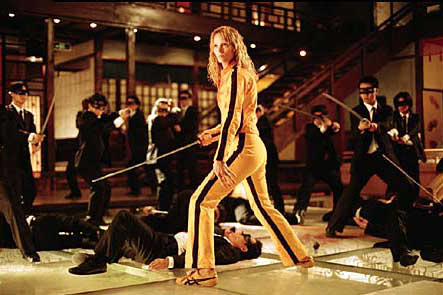

Corey Yuen Kwai’s HK contemporary action film “So Close” (2002) represents a point of reference for any extended discussion of “Kill Bill.” This title anticipates many of the same narrative conventions, yet remains faithful to those elements of Asian action genres that ground combat and vengeance imperatives in a rich personal context. Like “Kill Bill,” one of the principal plot axes of “So Close” involves a lethal contest between several strong female protagonists. Other comparable elements involve the casual dispatch of hordes of dark-suited male assistants, flamboyantly exaggerated wire- and CGI-assisted martial arts, and a vengeance-driven katana-wielding finale. However, “So Close” also includes scenes of relatively intense and intimate physical combat that engage the viewer with themes of love, rivalry, loss and passion within the narrative of a women’s relationship film. Newsweek’s film critic David Ansen commented on the longer action takes of “So Close,” whereas Tarantino observed that he had sought to make Thurman’s “The Bride” “scary.” It is precisely this contrast in how action scenes are integrated with the narrative that may underscore Ansen’s additional points about lack of emotional subtext in “Kill Bill.”


This points up the need for clarity in determining the significance of an unstoppable protagonist. Lee was arguably advancing both a cultural and personal agenda in his film parts. If “Kill Bill” invites identification of “The Bride” with Bruce Lee, the real message falls substantially short of expectation. Constructive editing and special effects can allow this equation to be drawn for those unfamiliar with the long takes possible with martial artists. But this seems ultimately less a homage than an anemic imitation. If there is a contemporary cultural implication it could connote the superiority of Western (American, Caucasian) individualism. After all, “The Bride” is evidently able to inspire and master the ultimate katana and use it to bloodily defeat legions of Japanese swordsmen after recovering from a coma – seemingly with ease. Worse, her character is permitted no solidarity with other women as she kills a culturally diverse group of female opponents. Contrast this with the unexpected bond forged in shared adversity between “Sue” (Vicky Zhao Wei) and “Hong” (Karen Mok Man-Wai) in “So Close.” Neither is infallible or unstoppable. It is precisely in their respective rejection of these inherently individualistic patriarchal myths that their characters find common ground – and a subversive romantic subtext. Unlike traditional samurai or wuxia films that deliver relatively traditional messages with their legitimate martial skills, Asian female action films often invite inherently political readings.

All written material copyrights
by T. P. (2003)